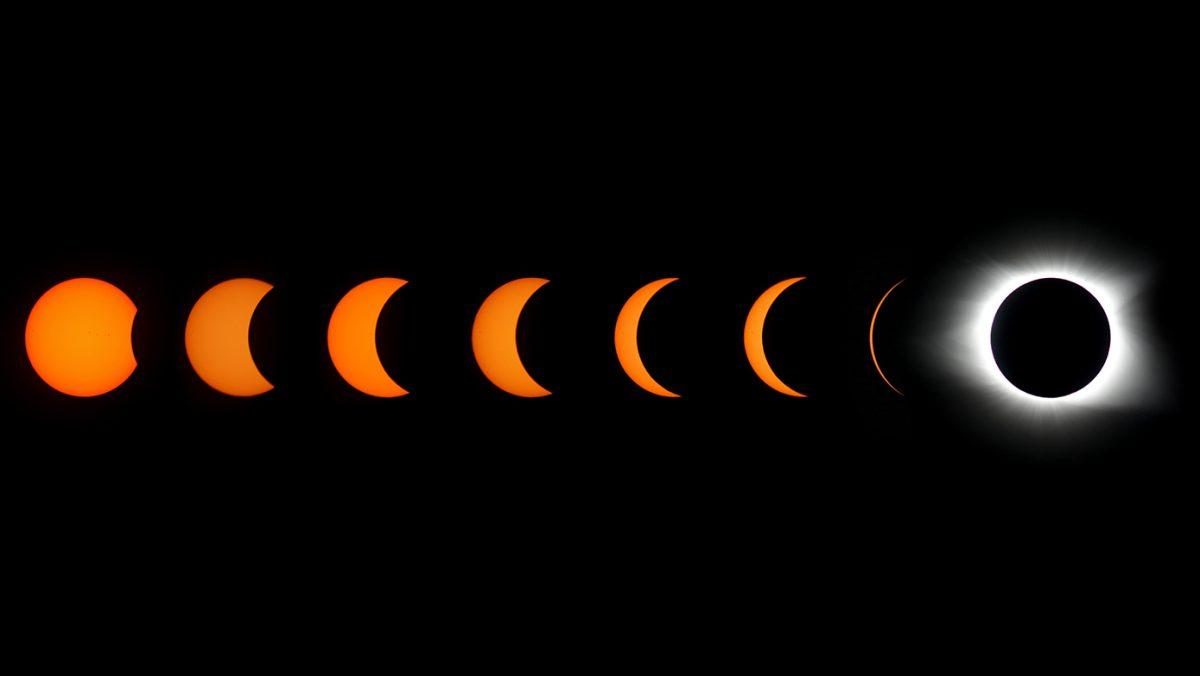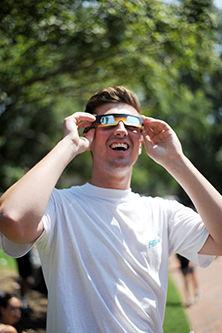In observation of the total solar eclipse on Monday, NC State’s College of Sciences hosted the Eclipse Day Celebration at the Brickyard to promote not only the scientific breakthroughs happening through NC State students and clubs, but also to encourage the community to come out and enjoy the historical moment.
Monday marked a unique celestial event. For the first time since June 1918, a total solar eclipse crossed the United States as 14 states observed the moon pass completely between the earth and the sun, an event known as totality.
Even though campus saw approximately 93 percent coverage of the sun, the eclipse reached total darkness for some nearby locations, including the Great Smoky Mountains and Charleston, South Carolina. A partial eclipse was visible in other locations around the country.
The partial disappearance and reappearance of the sun could be seen on campus beginning around 1:15 p.m. and ending a little after 4 p.m. with the peak coverage of the sun happening around 2:45 p.m.
“The eclipse is basically the blocking of the sun’s incoming solar radiation,” said Michael Mugrage, NC State’s Sounding Club president. “We expect to see a marked decrease in the temperature with changes in humidity and other indirect consequences from the changes.”
“Wild,” said Lauren Gilbert, a second-year studying communication, of her time viewing the event, noting the chirping of insects as peak viewing time approached, a result of the outdoor lighting being similar to that of dusk.
“I thought the eclipse was cool, but I think the best part was hearing the cicadas chirp,” Gilbert said.
Along with the spectacle of viewing the changes, several scientific research projects took place across the nation, including on NC State’s campus.
A highlight of the studies conducted near campus was the helium weather balloon sent up during the event by the NC State Sounding Club. As a part of a national project by NASA, the balloon recorded information on temperature and pressure of the atmosphere during the pinnacle of the eclipse at a height of about 80,000 feet.
“We are determining any kind of changes … within the layer of atmosphere closest to the surface,” said Shae McLamb, Sounding Club vice president.
Approximately 75 other sounding balloons around the country covered the project, which recorded video and photography for a live look at the eclipse as it swept the nation.
Through its measurements of weather data at such an altitude, scientists are comparing the recordings to that of Mars. With decreased lighting from the sun and the pressure and temperature at almost the same level as it is on Mars from the height of the balloons, scientists will conduct tests to see if onboard bacteria will survive its trip.
“I think it is going to be a really cool thing to watch,” McLamb said. “You might see cool videos online, but to see it live, in person and to watch it go up … there’s a lot of educational value as well.”
The College of Sciences prepared students for the phenomenon by providing special eclipse glasses to the first arrivals and pinhole telescopes to view the shadow of the sun without glasses.
There were also giveaways and educational demonstrations provided by the College of Sciences, including a small-scale weather balloon for kids to test and an interactive paper certificate that allowed people to track the coverage of the sun by placing stickers that matched what they observed as the moon moved from the beginning of the eclipse to the end.
“I found a new hobby in studying the stars and the moon,” said Glenna Sessoms, a first-year studying animal science.
Sessoms said she looks forward to comparing her view of the eclipse to what friends with greater sun coverage saw.
Because the next total solar eclipse will not happen in North America until 2024, and Raleigh will not be in an ideal location to view a total solar eclipse until 2052, it was important to many to appreciate the few minutes of exploring the wonder of the solar eclipse.
Nolan Joyce, a second year studying engineering, looks at the sun next to the Wolf Ears on Monday. Thousands of students gathered around the NC State Brickyard to enjoy eclipse festivities. Eclipse glasses were handed out to students and families attending the event.









